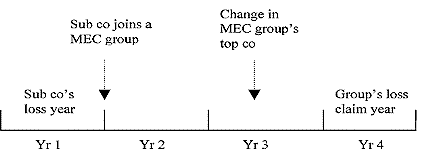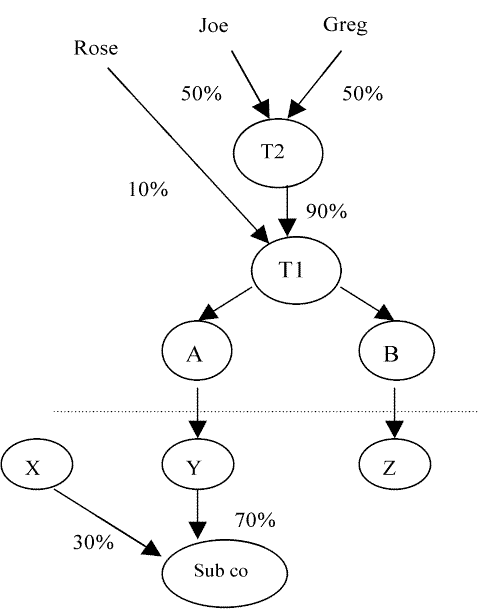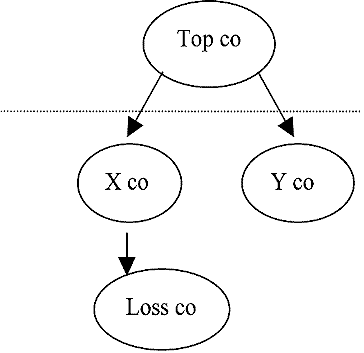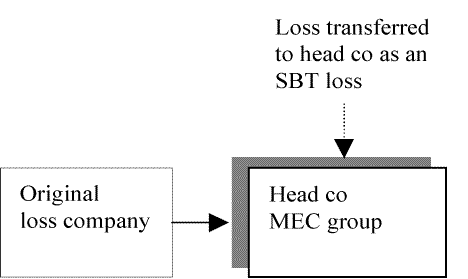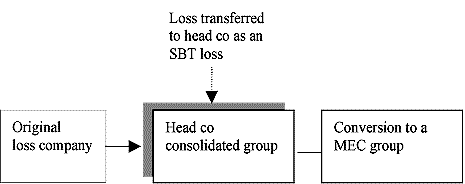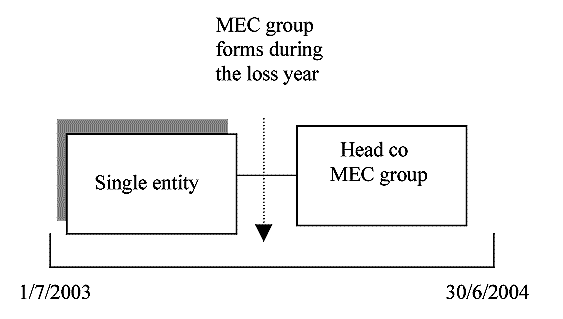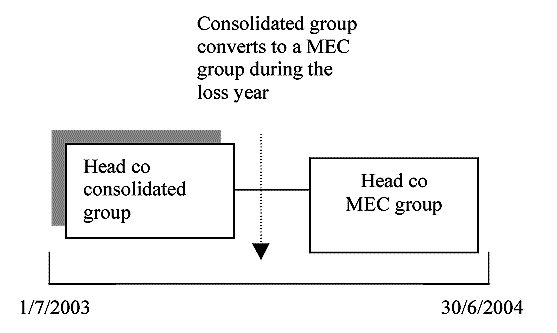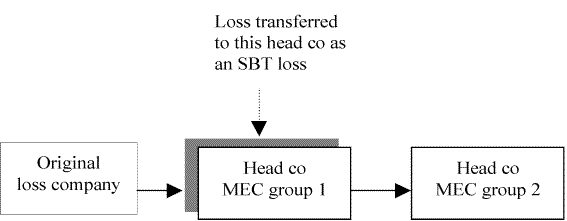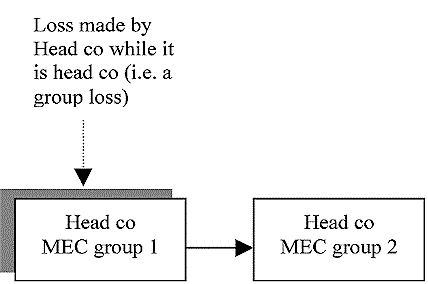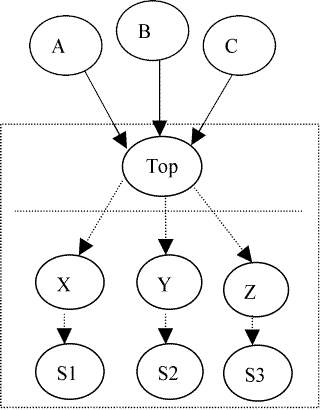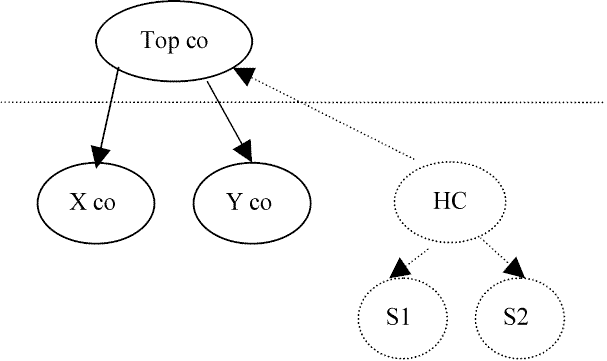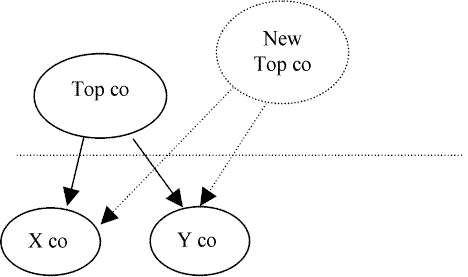Explanatory Memorandum
(Circulated by authority of the Treasurer, the Hon Peter Costello, MP)Chapter 3 - MEC groups: losses
Outline of chapter
3.1 This chapter explains modifications to the losses consolidation rules for MEC groups. The modifications are in Subdivision 719-F and:
- •
- explain how the COT applies to a MEC group; and
- •
- ensure the COT and SBT apply appropriately if the identity of a MEC group's head company changes.
3.2 References in this chapter are to the ITAA 1997, unless otherwise indicated.
Context of reform
3.3 Generally, the rules in Part 3-90 apply to a MEC group and its members in the same manner in which they apply to a consolidated group and its members. This is subject to the modifications in Division 719. This bill contains further modifications. Modifications are needed because a MEC group is structured differently to a consolidated group.
Applying the COT to MEC groups
3.4 The fact that a MEC group has multiple entry points (represented by each of its eligible tier-1 companies) rather than a single entry point (represented by a single Australian resident head company) presents difficulties in applying the COT to the group.
3.5 The COT is applied in determining whether a company, including the head company of a group, can use its losses. Broadly, a company satisfies the COT if it maintains substantially the same ownership from the start of the loss year until the end of the loss claim year.
3.6 For a consolidated group, the COT is applied by reference to the group's head company. But the head company of a MEC group is whichever of the group's eligible tier-1 companies is chosen by them as head company. Therefore, it is not appropriate to apply the COT to a MEC group by reference to its head company. That would mean a MEC group's tax position could change depending on which eligible tier-1 company was chosen as head company.
3.7 Also, applying the COT by reference to all of a MEC group's eligible tier-1 companies collectively is unworkable. The COT works to trace the ownership of a single loss entity. It cannot trace the ownership of a group of entities.
3.8 Therefore, the COT will be applied to a MEC group by reference to the group's top company - the group's foreign resident parent company. That is, a MEC group's top company will be treated in the same manner as the head company of a consolidated group. This means ownership changes that occur post-consolidation below the top company of a MEC group (i.e. in respect of interests held directly or indirectly by the top company) will be ignored in determining whether the head company of the MEC group has passed the COT in respect of any of its transferred or group losses.
3.9 However, consistent with the rules for consolidated groups, pre-consolidation ownership changes will continue to count in respect of a company from which a loss is transferred to the MEC group because the COT is passed.
Losses denied on dealings in membership interests below top company
3.10 Ownership changes below the top company level can only be ignored if such changes cannot be used as a means of duplicating the loss held by the group.
3.11 For changes in intra-group interests (broadly, interests below the eligible tier-1 level) this is achieved by the single entity rule which ignores such changes for income tax purposes and so dealings in them cannot give rise to a loss.
3.12 For interests in the group's eligible tier-1 companies, this will be achieved by adjusting the pooled cost bases of those interests on dealings in those interests. For interests in entities interposed between the eligible tier-1 companies and the group's top company, this will be achieved by rules which deny losses on dealings in those interests (unless the loss can be said to relate to an asset outside the MEC group). These rules are discussed in Chapter 11.
3.13 Applying the COT by reference to a MEC group's top company makes it necessary to deem a COT failure if the group's structure changes in a manner that makes continued testing through the top company inappropriate.
3.14 One example is when there is a change in the MEC group's top company as a result of a new top company acquiring relevant membership interests below the original top company. In this case the new top company could only have come about as a result of a 100% change in interests. Therefore, the deemed COT failure simply reflects what has actually occurred. The deeming is necessary because the approach of ignoring changes below the original top company means changes below that level would otherwise not be detected.
3.15 Another example is when the MEC group ceases to exist (e.g. because it converts to a consolidated group or because of some other event that breaks the group). In that case there will no longer be a top company. The losses will remain with the entity that was the head company of the MEC group when it ceased to exist. It is appropriate then that the focus of the COT test move back on-shore to the entity that still has the losses. But it is impossible to shift the focus from the top company down to an on-shore entity and continue COT testing. For that reason, a COT failure will generally be deemed when a MEC group ceases to exist.
Ensuring the change in head company rules apply appropriately
3.16 Section 719-90 ensures that a change in a MEC group's head company does not affect the group's tax position. It does this by transferring the old head company's history to the new head company. This bill includes rules to ensure that section 719-90 interacts appropriately with the COT rules discussed in this chapter and with the SBT.
Summary of new law
Applying the COT to MEC groups
3.17 Ownership changes that occur post-consolidation below the top company of a MEC group will be ignored in determining whether the head company of the MEC group has passed the COT in respect of any of its transferred or group losses. That is, the group's top company will be treated in the same manner as the head company of a consolidated group.
3.18 Generally, in determining whether the head company of a MEC group has passed the COT in respect of a loss, the COT is applied to the group's top company from the transfer time (if the loss is a transferred loss) or the beginning of the income year in which the head company made the loss (if the loss was generated by the group itself).
3.19 There is an exception if the loss was transferred to the group because the COT was passed by the transferor (called a COT transfer ). In that case the COT is applied to the transferor from the beginning of the income year in which it made the loss, but on the assumption that post-consolidation changes below the top company are ignored. This is consistent with the rules for consolidated groups contained in section 707-210.
3.20 The test company (i.e. the top company or transferor to which the COT is applied) will be deemed to have failed the COT if:
- •
- the potential MEC group ceases to exist;
- •
- the potential MEC group continues, but there is a change in its top company because something happens to membership interests below the top company; or
- •
- there ceases to be a provisional head company for the group.
3.21 Satisfaction or failure of the COT by the test company is attributed to the head company of the MEC group.
3.22 Other rules relevant to determining whether the head company can use the loss (e.g. the SBT and control test) are applied directly to the head company.
Ensuring the change in head company rules apply appropriately
3.23 The transfer of history under section 719-90 from an old head company to a new head company will not affect the application of the COT to the old head company. Also, in applying the SBT, a new head company takes into account the group's relevant business history and not things that happened to the new head company before it joined the group.
| New law | Current law |
|---|---|
|
In determining whether the head company of a MEC group has passed the COT in respect of a group loss or a transferred loss (other than a transferred COT loss) the ownership of the group's foreign resident holding company (top company) is tested. The test is applied from the transfer time or the beginning of the income year for which the group loss was made. |
In determining whether the head company of a consolidated group has passed the COT in respect of a group loss or a transferred loss (other than a transferred COT loss) the ownership of the group's head company is tested. The test is applied from the transfer time or the beginning of the income year for which the group loss was made. |
|
In determining whether the head company of a MEC group has passed the COT in respect of a transferred COT loss, the ownership of the transferor is tested, subject to certain assumptions. The test is applied from the start of the transferor's loss year. |
In determining whether the head company of a consolidated group has passed the COT in respect of a transferred COT loss, the ownership of the transferor is tested, subject to certain assumptions. The test is applied from the start of the transferor's loss year. |
| The application of the COT is not affected by the transfer of history from an old head company to a new head company under section 719-90. | It may be argued that the old head company no longer has an ownership history because it was transferred to the new head company. |
| In applying the SBT to the new head company of a MEC group, the new head company takes into account the group's business history and not things that happened to the new head company as a single entity before it joined the group. | It may be argued that a new head company must take into account its own business history accrued prior to it joining the group. |
Detailed explanation of new law
Applying the COT to MEC groups: the broad approach
3.24 Broadly, the COT is applied to the relevant test company on the basis of certain assumptions and the result is attributed to the group's head company. [Schedule 13, item 1, subsections 719-260(1) and (2)]
The steps in applying the COT to a MEC group
3.25 The steps in applying the COT to a MEC group are:
- •
- step 1: identify the test company for the loss:
- -
- this is the company to which the COT is applied;
- •
- step 2: assume the test company made the loss:
- -
- this allows the COT to be applied to the test company;
- •
- step 3: identify the start of the income year for which the test company is taken to have made the loss:
- -
- this marks the start of the test company's ownership test period (i.e. the time from which it commences to apply the COT); and
- •
- step 4: apply the COT to the test company ignoring ownership and voting changes up to the top company level while the loss is held by a MEC group:
- -
- also, the test company may be deemed to have failed the COT on the happening of certain events during the test company's ownership test period.
3.26 Examples 3.1 and 3.2 illustrate the application of the steps.
3.27 The terms 'test company', 'focal company' and 'COT transfer' are central to the rules. The expressions 'changes above top company' and 'changes below top company' are used in explaining the effect of the rules.
3.28 The company seeking to use the loss is called the focal company .
3.29 The focal company will generally be the head company of a MEC group. However, it may be the ex-head company of a MEC group that has ceased to exist or the head company of a consolidated group that has converted from a MEC group. This is discussed further in paragraphs 3.44 to 3.50.
3.30 The focal company will have made the loss because:
- •
- the loss was transferred to it under Subdivision 707-A (transferred loss); or
- •
- the loss was generated by a consolidated or MEC group of which it was the head company (group loss).
3.31 The company that is tested to determine whether the focal company has passed the COT in respect of the loss is called the test company .
3.32 The test company for the focal company will generally be the MEC group's top company. However, if the loss was transferred to the group's head company because the transferor passed the COT (a COT transfer ) the test company will be the transferor (or the earliest company transferor if there has been a series of COT transfers).
3.33 The focal company and the test company may be the same entity, though that will generally not be the case.
3.34 The transfer of a loss under Subdivision 707-A because the COT is passed is called a COT transfer . That is, the loss is transferred because the transferor meets the conditions in section 165-12. [Schedule 13, item 2, definition of 'COT transfer' in paragraph 707-210(1A)(a)]
3.35 However, the transfer is not a COT transfer if both the section 165-12 ownership test and the SBT in subsections 165-15(2) and (3) are passed (the control SBT). The control SBT applies if the control test is failed. If the control SBT is passed then the loss is more properly categorised as an SBT loss, because in the end an SBT was the reason the loss was transferred, even though the ownership test was also passed. [Schedule 13, item 2, definition of 'COT transfer' in paragraph 707-210(1A)(b)]
Changes above and below top company
3.36 The expressions 'changes above top company' and 'changes below top company', while not used in the legislation, are used in this explanation for brevity. They are illustrated in Diagram 3.1.
3.37 Changes above a MEC group's top company are taken into account in determining whether the group's head company has passed the COT. Broadly, this is a reference to changes in (direct or indirect) membership interests in a top company.
3.38 Changes below a MEC group's top company are not taken into account. This is a reference to changes in membership interests held directly or indirectly by a top company in group members, or in entities interposed between group members and a top company.
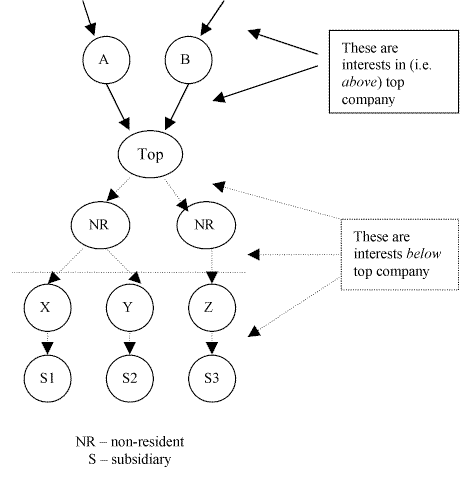
Comparison with the rules for consolidated groups
3.39 The approach to COT testing MEC groups is modelled on the rules for consolidated groups contained in section 707-210.
3.40 However, the rules for MEC groups are broader than those in section 707-210 in 2 respects:
- •
- first, they apply to
all
losses (whereas section 707-210 only applies to transferred COT losses):
- -
- this ensures that a MEC group's top company is tested in respect of SBT losses, trust losses and group losses. There is no equivalent rule for consolidated groups because under the single entity rule the COT is automatically applied to the group's head company in respect of such losses; and
- •
- second, they provide for interactions between the rules for consolidated groups and those for MEC groups in the event that a loss has passed from a consolidated group to a MEC group or from a MEC group to a consolidated group. Broadly:
- -
- the rules in section 707-210 apply if the loss has only ever been held by a consolidated group;
- -
- the rules discussed in this chapter apply if the loss has only ever been held by a MEC group;
- -
- the rules discussed in this chapter apply to ensure continuous COT testing of a loss that moves from a consolidated group to a MEC group as a COT loss; and
- -
- the rules discussed in this chapter apply to deem a COT failure of a loss if it is sought to be moved from a MEC group to a consolidated group.
3.41 Therefore, in determining whether a head company (or an ex-head company that is still holding the group's losses) has passed the COT the starting point is determining which set of rules apply - those for consolidated groups in section 707-210 or those discussed in this chapter.
Examples illustrating the application of the COT testing steps
3.42 Examples 3.1 and 3.2 illustrate the application of the 4 steps used to determine whether the head company of a MEC group has passed the COT. Example 3.1 is a theoretical application of the 4 steps to a set of facts. Example 3.2 is a practical application of the steps (using actual figures) to the same set of facts.
Example 3.1
Year 1 - Sub co makes a loss.
Year 2 - Sub co joins a MEC group on the first day of year 2. At the joining time there is a COT transfer of Sub co's loss to the group's head company.
Year 3 - there is a change in the MEC group's top company.
Year 4 - the MEC group's head company seeks to recoup the loss.
The MEC group's head company is the focal company. It can use the loss provided the test company could have used the loss.
Step 1: identify the test company
The test company is Sub co:
- •
- first, item 2 in the table in subsection 719-265(2) applies because the focal company made the loss as a result of a COT transfer and the focal company and the transferor are different companies. Item 2 identifies the test company as the entity that is the test company for the transferor. The transferor is Sub co [Schedule 13, item 1, subsection 719-265(2), item 2 in the table] ; and
- •
- the rules for identifying the test company are applied again, this time assuming that Sub co is the focal company. Item 3 in the table in subsection 719-265(4) applies. It identifies the test company as the focal company (i.e. Sub co) [Schedule 13, item 1, subsection 719-265(4), item 3 in the table] .
Step 2: assume the test company made the loss
Sub co is taken to have made the loss even though it has been transferred to the head company.
Step 3: identify the start of the test company's loss year
Sub co's loss year starts at the start of year 1:
- •
- item 1 in the table in subsection 719-270(4) applies because Sub co made the loss other than by way of a transfer under Subdivision 707-A (i.e. it is Sub co's own loss). Therefore, Sub co is taken to have made the loss from the start of the income year in which it actually made it (i.e. the start of year 1). [Schedule 13, item 1, subsection 719-270(4), item 1 in the table]
Step 4: ignore ownership changes below top company
First, after the transfer, assume nothing happens to membership interests or voting power in Sub co or in any entity interposed between Sub co and the group's first top company.
Second, after the change in Top co, assume nothing happens to membership interests or voting power in the original Top co or in any entity interposed between it and the new Top co.
Example 3.2
This example continues Example 3.1. It shows whether the COT is passed in respect of the loss using actual figures.
The diagram shows Sub co's ownership structure at the start of its loss year (i.e. year 1) - 30% of it is owned by X co and 70% by Y co.
During that year, Y co acquires the remaining 30% interest in Sub co from X co.
Event - Sub co transfers its loss to a MEC group
The MEC group forms at the beginning of year 2, comprising Y co, Z co and Sub co. On formation, Sub co transferred its loss to Y co, the group's head company.
Event - change in the group's top company
During year 3, T2 acquires Rose's 10% interest in T1. This results in T2 replacing T1 as the group's top company:
- •
- also, in year 3, B co acquires some of A co's shares in Y co so that B co owns 15% of Y co and A co owns 85%.
Is the COT passed?
The head company (i.e. Y co) passes the COT when it seeks to use the loss in year 4 if Sub co would have passed it.
The COT is applied to Sub co on the basis of the assumptions identified in Example 3.1.
Sub co takes these ownership changes into account:
- •
- its pre-consolidation changes (i.e. Y co's acquisition of X co's interest in Sub co); and
- •
- post-consolidation changes in T1 up until, and including, T2's acquisition of Rose's 10% interest.
The post-consolidation changes in Y co (i.e. B co's acquisition of some of A co's interests) are ignored in determining whether the COT is passed. However, these changes will require adjustments to the pooled cost bases of interests in Y co and Z co. This is discussed in Chapter 11.
For the purpose of this example, assume that all shares carry equal voting, dividend and capital rights.
Sub co (and therefore head company) passes the COT because 63% of Sub co's ultimate ownership has continued from the start of its loss year to the end of the head company's claim year.
Shareholder Shareholdings that can be counted to pass the COT Percentage held Joe 50% * 90% * 70% 31.5% Greg 50% * 90% * 70% 31.5% Total 63%
Applying the COT to MEC groups: the detailed rules
3.43 The next part of this chapter provides a more detailed explanation of each of the rules.
3.44 The rules apply to a company seeking to utilise a loss (the focal company). That is, to a focal company seeking to recoup a loss or transfer it to another group. The rules apply in determining whether the focal company has passed the COT in section 165-12 in respect of the loss. They apply if the focal company was the head company of a MEC group at any time during its ownership test period for the loss. [Schedule 13, item 1, subsection 719-255(1)]
What is the focal company's ownership test period?
3.45 Generally, a focal company's ownership test period is the period from the start of the income year for which the focal company made the loss to the end of the income year for which it is seeking to use the loss (see subsection 165-12(1)). For a transferred loss, the period starts at the transfer time (see section 707-205).
3.46 For both transferred and group losses, the period ends at the end of the trial year if the focal company is seeking to transfer the loss to another group (see section 707-120).
Loss may previously have been held by a consolidated group
3.47 The focal company may not have been the head company of a MEC group at the start of its ownership test period. At the start of the period it may have been the head company of a consolidated group that, before the end of the period, converts to a MEC group under a special conversion event in section 719-40.
3.48 Because the loss may previously have been held by a consolidated group it is specifically stated that in such cases the rules discussed in this chapter apply instead of the COT testing rules for consolidated groups contained in section 707-210. [Schedule 13, item 1, subsection 719-255(2)]
3.49 Another example of the rules applying when the loss had previously been held by a consolidated group is a loss transferred to the focal company by the head company of a consolidated group that is acquired by the focal company's MEC group. However, in that case the focal company will have been a head company of a MEC group at the start of its ownership test period.
Loss may no longer be held by a MEC group
3.50 The focal company need not be the head company of a MEC group at the end of its ownership test period. The rules continue to apply in determining the focal company's ability to use the loss even if the MEC group has ceased to exist (e.g. the MEC group has deconsolidated or converted to a consolidated group). In these cases, the rules will apply to deem a COT failure in respect of the loss. This is discussed further in paragraphs 3.114 to 3.118.
Step 1: identify the test company
3.51 The identity of the test company depends on how the loss was made by the focal company. Broadly, the test company will be the top company of the MEC group, unless the loss is a transferred COT loss in which case the test company will be the transferor. [Schedule 13, item 1, paragraph 719-265(1)(a)]
3.52 There is no requirement that the test company still be a member of the group that is seeking to use the loss.
Example 3.3
A MEC group forms, comprising X co, Y co and Loss co.
On formation, Loss co transfers its loss to the group's head company. The transfer is a COT transfer. Therefore, Loss co is the test company.
Before the group has used the loss, Loss co leaves. However, the loss stays with the group and the group can use it, despite Loss co's exit.
Also, Loss co continues to be the test company, but on the assumption that its ownership structure is frozen to that which existed immediately after formation. That is, the fact that Loss co has left is ignored. This matches the rules for consolidated groups in section 707-210 and is explained further in paragraphs 3.87 to 3.113.
3.53 The rules for identifying the test company also accommodate the possibility that, at the transfer time or the beginning of the income year in which a group loss was made, the focal company was the head company of a consolidated group. In that case, the test company is identified by reference to the consolidated group.
Loss transferred to focal company because the SBT was passed
3.54 For a loss transferred to the focal company as the head company of a MEC group because the SBT is passed, the test company will be the top company of the MEC group at the transfer time. [Schedule 13, item 1, subsection 719-265(3), item 1 in the table]
Example 3.4
The test company is the top company of the MEC group at the transfer time.
3.55 However, the test company will be the focal company if the focal company was the head company of a consolidated group at the transfer time. [Schedule 13, item 1, subsection 719-265(3), item 2 in the table]
Example 3.5
The loss was first transferred to the head company of a consolidated group. Subsequently the group converts to a MEC group under section 719-40. This means the head company of the consolidated group becomes the head company of the MEC group.
The test company is the focal company. That is, the head company of the MEC group (previously the head company of the consolidated group).
Loss transferred to the focal company by a trust
3.56 For a trust loss transferred to the focal company as the head company of a MEC group, the test company will be the top company of the MEC group at the transfer time. [Schedule 13, item 1, subsection 719-265(4), item 2 in the table]
Example 3.6
The test company is the top company of the MEC group at the transfer time.
3.57 However, the test company will be the focal company if the focal company was the head company of a consolidated group at the transfer time. [Schedule 13, item 1, subsection 719-265(4), item 3 in the table]
Loss made by the focal company as a group loss
3.58 For a group loss, the test company will be the top company of the MEC group at the start of the income year for which the loss was made. [Schedule 13, item 1, subsection 719-265(4), item 1 in the table]
3.59 However, the test company will be the focal company if the focal company was not the head company of a MEC group at the start of the loss year. [Schedule 13, item 1, subsection 719-265(4), item 3 in the table]
3.60 One example of this is a loss made by the head company of a MEC group in the income year in which the group formed where the group formed part way through the year. There is no formal transfer of such a loss to the group under Subdivision 707-A - it is essentially a group loss. In this case, the head company (i.e. the focal company) would not have been the head company of the MEC group at the beginning of the income year. Therefore, the head company will be the test company.
Example 3.7
The head company of the MEC group makes a loss for the 2003-2004 income year. For the first part of that year, the head company was a single entity. For the second part, it was the head company of a MEC group.
It seeks to use the loss in a later income year. It is therefore the focal company. It is also the test company.
3.61 In the scenario outlined in Example 3.7, it would not be appropriate for the group's top company to be the test company because the group did not form (and therefore there was no top company) until part way through the loss year. The step 4 rules discussed in paragraphs 3.87 to 3.113 ensure that, after formation, changes in interests held by the top company in the test company (or in any entities interposed between the test company and the top company) will be ignored.
3.62 Another example is a loss made by the head company of a consolidated group that later converts to a MEC group. Again, there is no formal transfer of the loss to the MEC group.
Example 3.8
The head company of the MEC group makes a loss for the 2003-2004 income year. For the first part of that year, it was the head company of a consolidated group. As a result of that group converting to a MEC group during the year, it becomes the head company of a MEC group.
It seeks to use the loss in a later income year. It is therefore the focal company. It is also the test company.
3.63 The term 'group loss' is not used in the law. Instead, the law refers to a loss made apart from Subdivision 707-A. A loss made by a company in its capacity as a single entity and later transferred to itself in its capacity as the head company of a MEC or consolidated group could also be described as a loss made by that entity apart from Subdivision 707-A. Therefore, it is made clear that the test company for such a loss is to be identified by reference to the rules for transferred SBT or COT losses rather than the rules for group losses. [Schedule 13, item 1, subsection 719-265(5)]
Loss transferred to the focal company as a COT loss
3.64 For a loss transferred to the focal company as a COT loss, the test company will be the transferor (regardless of whether the focal company was the head company of a MEC or consolidated group at the transfer time). [Schedule 13, item 1, paragraph 719-265(1)(b), subsection 719-265(2), item 2 in the table and subsection 719-265(4), item 3 in the table]
3.65 The transferor and the focal company will be the same entity if the loss was made by the focal company outside the group and transferred to itself in its capacity as the head company of a MEC or consolidated group. In that case, the focal company is identified as the test company. [Schedule 13, item 1, subsection 719-265(2), item 1 in the table]
3.66 Also, the rules are drafted so as to identify the earliest transferor company as the test company if there has been a series of COT transfers. That is, the test company may be traced back through one or more COT transfers. Therefore, more than one application of the rules may be needed in order to identify the test company. [Schedule 13, item 1, paragraph 719-265(1)(b), item 1 in the table]
3.67 A repeat application of the rules is needed if there is a COT transfer of the loss to the focal company and the transferor and the focal company are different entities. (If they are the same entity, then that entity is the test company and no further testing is needed.)
3.68 In applying the rules again, the transferor is treated as though it is the focal company. That is, as if the transferor still had the loss and was seeking to use it. The aim this time is to identify the test company for the transferor. This process is repeated until the first COT transferor is identified. That entity will be the test company.
Example 3.9
The loss is transferred from the original loss-making company to the head company of the MEC group when the original loss-maker joins the group. The transfer is a COT transfer.
The focal company is the head company of the MEC group. The test company is identified using the tables in subsections 719-265(2) and (4). [Schedule 13, item 1, subsections 719-265(2) and (4)]
First, item 2 in the table in subsection 719-265(2) applies because the focal company made the loss as a result of a COT transfer and the focal company and the transferor are different companies. It identifies the test company as the entity that is the test company for the transferor - in this case, the original loss company. [Schedule 13, item 1, subsection 719-265(2), item 2 in the table]
To work out the test company for the original loss company, the rules for identifying the test company are applied again, this time assuming that the original loss company is the focal company. Item 3 in the table in subsection 719-265(4) applies because, on the basis of that assumption, none of the other provisions apply. It identifies the test company as the focal company (i.e. the original loss company). [Schedule 13, item 1, subsection 719-265(4), item 3 in the table]
Example 3.10
The facts are the same as Example 3.9 except there has been a COT transfer of the loss to the head company of MEC group 2.
The focal company is the head company of MEC group 2. The test company is identified using the tables in subsections 719-265(2) and (4). [Schedule 13, item 1, subsections 719-265(2) and (4)]
First, item 2 in the table in subsection 719-265(2) applies because the focal company made the loss as a result of a COT transfer and the focal company and the transferor are different companies. It identifies the test company as the entity that is the test company for the transferor - in this case, the head company of MEC group 1. [Schedule 13, item 1, subsection 719-265(2), item 2 in the table]
To work out the test company for the head company of MEC group 1, the rules for identifying the test company are applied again, this time assuming that the head company of MEC group 1 is the focal company. The process from this point is the same as that explained in Example 3.9 resulting in the original loss company being the test company. [Schedule 13, item 1, subsection 719-265(4), item 3 in the table]
Example 3.11
The loss is transferred from the original loss-making company to the head company of MEC group 1 because the SBT was passed. There is then a COT transfer of the loss to the head company of MEC group 2.
The focal company is the head company of MEC group 2. The test company is identified using the tables in subsections 719-265(2) and (3). [Schedule 13, item 1, subsections 719-265(2) and (3)]
First, item 2 in the table in subsection 719-265(2) applies. It identifies the test company as the entity that is the test company for the transferor. The transferor is the head company of MEC group 1. [Schedule 13, item 1, subsection 719-265(2), item 2 in the table]
To work out the test company for the head company of MEC group 1, the rules for identifying the test company are applied again, but on the assumption that the head company of MEC group 1 is the focal company. The table in subsection 719-265(3) applies because the loss was transferred to the head company of MEC group 1 because the SBT was passed. Item 1 in the table identifies the test company as the top company of MEC group 1 when the loss was transferred to MEC group 1. [Schedule 13, item 1, subsection 719-265(3), item 1 in the table]
Example 3.12
A group loss is made by the head company of MEC group 1. It was the head company of MEC group 1 for the whole of the loss year. Subsequently, there was a COT transfer of the loss to the head company of MEC group 2.
The focal company is the head company of MEC group 2. The test company is identified using the tables in subsections 719-265(2) and (4). [Schedule 13, item 1, subsections 719-265(2) and (4)]
First, item 2 in the table in subsection 719-265(2) applies. It identifies the test company as the entity that is the test company for the transferor. The transferor is the head company of MEC group 1. [Schedule 13, item 1, subsection 719-265(2), item 2 in the table]
To work out the test company for the head company of MEC group 1, the rules for identifying the test company are applied again, but on the assumption that the head company of MEC group 1 is the focal company. Item 1 in the table in subsection 719-265(4) applies because the head company of MEC group 1 made the loss apart from Subdivision 707-A (and it was the head company of the group at the start of the loss year). It identifies the test company as the top company of MEC group 1 at the start of the loss year. [Schedule 13, item 1, subsection 719-265(4), item 1 in the table]
Step 2: assume the test company made the loss
3.69 This allows the COT to be applied to the test company. [Schedule 13, item 1, subsections 719-270(1), (2) and (4)]
3.70 It means that a test company that has never made the loss (i.e. a top company) can nonetheless apply the COT.
3.71 The assumption also applies where the test company has at some stage made the loss but has since transferred it to itself or another company. In those cases, the assumption reinstates the test company as the loss-maker. The fact that the test company has since transferred the loss does not disturb the assumption. [Schedule 13, item 1, subsection 719-270(6)]
Step 3: identify the start of the test company's loss year
3.72 The COT is applied to the test company for its ownership test period. This is the period from the start of the test company's loss year until the end of the income year in which the head company seeks to use the loss.
3.73 The start of the test company's loss year depends on the identity of the test company and the nature of the loss.
3.74 Again, the fact that the test company may have since transferred the loss - either to itself or to another company - does not disturb the time that is pinpointed as the start of its loss year. [Schedule 13, item 1, subsection 719-270(6)]
The test company is the top company of the focal company's MEC group
3.75 If the test company is the top company for the focal company's MEC group, the start of the test company's loss year matches the start of the focal company's ownership of the loss.
3.76 The test company's loss year will start at the start of the income year for which the focal company made the loss if the focal company made the loss as a group loss. [Schedule 13, item 1, subsection 719-270(1), item 1 in the table]
3.77 The test company's loss year will start at the transfer time if the loss was transferred to the focal company. [Schedule 13, item 1, subsection 719-270(1), item 2 in the table]
The test company was the top company of an earlier MEC group
3.78 If the test company was the top company for an earlier MEC group, the start of the test company's loss year matches the start of the period of loss ownership for the focal company of that earlier MEC group. [Schedule 13, item 1, subsection 719-270(4), item 3 in the table]
3.79 In Example 3.11, the top company for MEC group 1 was identified as the test company. The start of its loss year is set by reference to the focal company for MEC group 1. It will therefore be the time the loss was transferred to the focal company for MEC group 1.
The test company is the first loss-making company
3.80 If the test company is the first loss-making company of a loss that has been transferred on one or more occasions as a COT loss, the start of the test company's loss year matches the start of its original ownership period for the loss.
3.81 The test company's ownership period for the loss depends on how it made the loss. The test company may have generated the loss itself. Alternatively, the loss may have been transferred to it other than as a COT loss (e.g. because the SBT was passed).
3.82 The test company's loss year will begin at the start of the income year for which the test company originally made the loss if it generated the loss itself. [Schedule 13, item 1, subsection 719-270(4), item 1 in the table]
3.83 However, if the test company made the loss because the loss was transferred to it, then its loss year will start at the transfer time. [Schedule 13, item 1, subsection 719-270(4), item 2 in the table]
The test company and the focal company are the same entity
3.84 The test company may be both the original loss-making company and the focal company. That is, the test company and the focal company are the same entity. Again, the start of the test company's loss year matches the start of its original ownership period for the loss.
3.85 That is, the test company's loss year will begin at the start of the income year for which the test company originally made the loss. [Schedule 13, item 1, subsection 719-270(2), item 1 in the table]
3.86 However, if the test company originally made the loss because it was transferred to it by another entity or it transferred it to itself because the SBT was passed, then its loss year will start at the transfer time. [Schedule 13, item 1, subsection 719-270(2), item 2 in the table]
Step 4: ignore ownership changes below top company
3.87 Post-consolidation ownership changes below a MEC group's top company are ignored.
3.88 No special rules are needed to achieve this outcome if the test entity is the top company of the focal company's MEC group. That is, applying the COT to the top company naturally means that only changes in the top company (i.e. above it) are taken into account. This applies, for example, to losses generated by the MEC group itself and to losses transferred to the group because the SBT was passed.
3.89 However, special rules are needed if the test company is a company other than the top company for the focal company's MEC group. Special rules apply, for example, to losses transferred to a MEC group where the transfer was a COT transfer.
3.90 Broadly, each time there is a COT transfer of a loss to a MEC group (or the group gets a new top company) it is assumed that nothing happened after that time to membership interests or voting power in entities below the group's top company (or new top company) that would affect whether the test company met the conditions in section 165-12. This achieves 3 things:
- •
- first, it ensures that changes that occur before the transfer (or the new top company) are counted;
- •
- second, it freezes the ownership structure below the group's top company to that which exists immediately after the transfer (or new top company) time; and
- •
- third, it ignores the test company's exit from the group, including ownership changes that trigger the exit.
[Schedule 13, item 1, subsection 719-275(2)]
3.91 Ignoring a test company's exit from the group is consistent with the general consolidation model which provides that tax attributes transferred to a group remain with the group for use by it even if the entity that transferred the attributes leaves the group. It is also matches the approach taken in section 707-210.
3.92 The rules are drafted to incorporate an assumption that freezes the relevant ownership structure. The assumption must be made whenever any one of 5 listed events occurs during the test company's ownership test period. That is, whenever one of the events occur between the start of the test company's loss year and the end of the head company's claim year. More than one event may occur during the period. Also, the same event may occur more than once during the period. [Schedule 13, item 1, subsection 719-275(1)]
Event 1: COT transfer to a MEC group (from a single entity or the head company of a consolidated group)
3.93 This event occurs if there is a COT transfer of the loss to a MEC group from a single entity or from the head company of a consolidated group. (A transfer from the head company of a MEC group is covered by event 2. Transfers that are not COT transfers are not covered at all because there is no need - that is, the top company of the MEC group will be the test company.)
3.94 The COT is applied to the test company on the assumption that, after the transfer, nothing happens to the membership interests or voting power in the transferor (i.e. the single entity or the head company of the consolidated group). It is also assumed that nothing happens to any entity interposed between the transferor and the MEC group's top company. [Schedule 13, item 1, subsection 719-275(2), item 1 in the table]
3.95 This ensures that ownership changes in the transferor up to the transfer time continue to be relevant. After the transfer time, only ownership changes in the top company are relevant.
Example 3.13
A MEC group forms comprising: X co, Y co, Z co, S1, S2 and S3.
On formation there is a COT transfer of a loss from S1 to the group's head company which is Z co. S1 is the test company.
The COT is applied to S1 on the basis of its ownership structure that existed at the formation time and which is within the diagram square.
Therefore, in applying the COT to S1, the subsequent exit of S1 from the group would be ignored. If the top company rolled down some or all of the interests it held in X co so, for example, they were held by Y co, that would be ignored for COT purposes. If the top company sold all of its interests in X co to an entity outside the group, resulting in X co and S1 leaving the group, that would be ignored.
Event 2: COT transfer to a MEC group (from the head company of another MEC group)
3.96 This event occurs if there is a COT transfer of the loss to a MEC group from the head company of another MEC group.
3.97 The COT is applied to the test company on the assumption that, after the transfer, nothing happens to the membership interests or voting power in the top company of the transferor's MEC group or in any entity interposed between it and the top company of the transferee's MEC group. [Schedule 13, item 1, subsection 719-275(2), item 2 in the table]
3.98 This ensures that ownership changes in the top company of the transferor's MEC group up to the transfer time continue to be relevant. After the transfer time, only ownership changes in the top company of the transferee's MEC group are relevant.
3.99 Changes below the top company of the transferor's MEC group will already be ignored - either because that top company is the test company or because of a previous application of event 1.
3.100 Event 2 will only apply if the top company of one MEC group (the first group) acquires all of the membership interests in the top company of another MEC group (the second group). If the first group acquired the second group in any other manner (e.g. the first group acquired all of the second group's eligible tier-1 companies) the second group will be deemed to have failed the COT. Therefore, while losses held by the second group could still be transferred to the first group, the transfer could not be a COT transfer and so event 2 could not apply. The circumstances in which the COT is deemed to be failed are discussed in paragraphs 3.114 to 3.118.
Event 3: change in identity of a MEC group's top company
3.101 This event occurs if there is a change in identity of a MEC group's top company but the MEC group continues in existence (so the group's losses are retained by the group and are not transferred to any other company).
3.102 The COT is applied to the test company on the assumption that, after the change in top company, nothing happens to the membership interests or voting power in the former top company or in any entity interposed between it and the new top company. [Schedule 13, item 1, subsection 719-275(2), item 3 in the table]
3.103 This event applies, for example, if the group's top company becomes a wholly-owned subsidiary of another foreign resident. That other foreign resident would become the new top company. Changes in the former top company leading to the change are relevant. After that, only changes in the new top company are relevant. See Examples 3.1 and 3.2.
3.104 This event only applies to a loss held by the MEC group at the event time. Because the test company is taken to have made the loss, it is necessary to reinstate the group's head company as the loss-maker in order to ensure this link between the loss and the event. [Schedule 13, item 1, subsection 719-275(3)]
Event 4: company becomes the head company of a MEC group
3.105 This event occurs if a company makes a loss and becomes the head company of a MEC group and the company's losses are not transferred to itself as head company at that time.
3.106 The COT is applied to the test company on the assumption that, after the company became the head company of the MEC group, nothing happens to membership interests or voting power in the head company or in any entity interposed between it and the new top company. [Schedule 13, item 1, subsection 719-275(2), item 4 in the table]
3.107 All changes in the entity up until it becomes the head company of a MEC group will be relevant. But after that only changes above the MEC group's top company are relevant.
3.108 This event applies in respect of:
- •
- prior year losses held by the head company of a consolidated group when the group converts to a MEC group:
- -
- losses are not transferred when a group converts from one group type to another; and
- •
- losses made by an entity for the income year in which the MEC group formed (either from scratch or as a result of a conversion):
- -
- such losses are not transferred because a head company that forms a consolidated group part way through its income year does not work out its taxable income or loss up to the joining time.
3.109 This event also only applies to a loss held by the MEC group at the event time. Because the test company is taken to have made the loss, it is necessary to reinstate the group's head company as the loss-maker in order to ensure this link between the loss and the event. [Schedule 13, item 1, subsection 719-275(3)]
Event 5: COT transfer to the head company of a consolidated group
3.110 This event occurs if there is a COT transfer of a loss to the head company of a consolidated group from another company.
3.111 The COT is applied to the test company on the assumption that, after the transfer, nothing happens to membership interests or voting power in the other company or in any entity interposed between it and the head company. [Schedule 13, item 1, subsection 719-275(2), item 5 in the table]
3.112 This event will apply if the test company was previously a member of a consolidated group. It matches the outcome for consolidated groups under section 707-210. It ensures that freezes to the ownership structure of a consolidated group continue after the loss has been transferred from the consolidated group to a MEC group. It is needed because section 707-210 no longer applies once a loss has been transferred to a MEC group. [Schedule 13, item 1, subsection 719-255(2)]
3.113 This event does not apply if the test company made the loss in its capacity as a single entity and transferred it to itself in its capacity as the head company of a consolidated group. There is no need for the event to apply in that case. That is, there is no need to freeze the ownership structure of the consolidated group in respect of pre-consolidation losses made by the group's head company because for such losses only changes above the head company are relevant.
3.114 The test company will be taken to have failed the COT in respect of a loss if any of these things happen to the focal company's MEC group or potential MEC group after the start of the focal company's ownership test period for the loss:
- •
- the potential MEC group ceases to exist;
- •
- the potential MEC group continues to exist but there is a change in its top company because something happens to membership interests in the MEC group's eligible tier-1companies or an entity interposed between the eligible tier-1 companies and the group's top company; or
- •
- there ceases to be a provisional head company for the group.
[Schedule 13, item 1, subsections 719-280(1) to (4)]
3.115 These are of course not the only circumstances in which the test company may fail the COT. It will also fail the COT if it fails to meet the conditions in section 165-12 on the basis of the assumptions discussed in paragraphs 3.51 to 3.113 [Schedule 13, item 1, subsection 719-280(5)] . If that happens before the deemed COT failure time, then the COT failure time is taken to be the earlier time [Schedule 13, item 1, subsection 719-260(2)] .
The potential MEC group ceases to exist
3.116 A potential MEC group would cease to exist, for example, if the group's top company no longer satisfied the conditions for being a top company because it became an Australian resident or a wholly-owned subsidiary of an Australian resident (see subsection 719-10(7)). A potential MEC group would also cease to exist if the relevant MEC group converted to a consolidated group (see section 703-55 and subsection 719-10(7)).
Example 3.14
The MEC group comprises X co and Y co. The group's head company is X co. The group's top company is acquired by the head company of a consolidated group. As a result, the potential MEC group ceases to exist. Therefore, the COT will be deemed to have been failed in respect of any losses held by X co.
There is a change in the top company for a potential MEC group
3.117 A potential MEC group will continue to exist despite a change in its top company if all of the eligible tier-1 companies that were members of the group before the change are still members of the group after the change (see subsection 719-10(8)). But the test company will be deemed to have failed the COT where this happens as a result of an acquisition of interests below the group's top company (i.e. in the group's eligible tier-1 companies or in an entity or entities interposed between the eligible tier-1 companies and the original top company).
Example 3.15
The MEC group comprises X co and Y co. The group's head company is X co. The group's top company changes as a result of the new top co acquiring all of the interests in X co and Y co. The COT will be deemed to have been failed in respect of any losses held by X co.
However, there would be no deemed COT failure if the new top co acquired all of the interests in the original top company (though that may bring about an actual COT failure).
There ceases to be a provisional head company
3.118 A MEC group ceases to exist if it ceases to have a provisional head company (see paragraph 719-5(7)(c)).
Attributing a test company's COT results to the focal company
3.119 The result of applying the COT to the test company is attributed to the focal company.
3.120 If the test company passes the COT (i.e. it meets the conditions in section 165-12) on the basis of the rules discussed in paragraphs 3.51 to 3.118, then the focal company is taken to meet the conditions in section 165-12. [Schedule 13, item 1, subsection 719-260(1)]
3.121 If the test company would have failed the COT on the basis of the rules discussed in paragraphs 3.51 to 3.118, then the focal company is taken to fail the COT. [Schedule 13, item 1, subsection 719-260(2)]
3.122 The time at which the focal company is taken to fail is relevant in applying the SBT to the focal company. Generally, the focal company is taken to have failed the COT at the time the test company fails it. [Schedule 13, item 1, paragraph 719-260(2)(a)]
3.123 However, if the test company is a listed public company (or 100% subsidiary) to which Division 166 applies, then the focal company is taken to have failed at the test company's test time that triggered the failure. [Schedule 13, item 1, paragraph 719-260(2)(b)]
3.124 Because there are 2 ways the test company can fail - a failure of section 165-12 or a deemed failure - it is specified that the focal company will be taken to fail the COT at the time the test company first failed under either test. For example, if the test company failed as a result of applying section 165-12 (on the basis of the assumptions discussed in paragraphs 3.51 to 3.113) and later is deemed to have failed (because one of the events described in paragraphs 3.114 to 3.118 occurs), the focal company is taken to fail at the earlier failure time. [Schedule 13, item 1, paragraph 719-260(2)(a) and subparagraph 719-260(2)(b)(ii)]
3.125 Regardless of how the test company failed, a further rule is needed to ensure that the SBT can be applied if the focal company is a listed public company (or 100% subsidiary) to which Division 166 applies. In that case, the focal company's test time, for the purpose of applying the SBT in subsection 166-5(5), is taken to be the focal company's failure time worked out under the rules discussed in paragraphs 3.122 to 3.124. [Schedule 13, item 1, subsection 719-260(3)]
Test company fails: interaction with the modified transfer SBT
3.126 If the COT is being applied for the purpose of determining whether the focal company can transfer the loss to a new group, then the rules that determine the timing of the COT failure must interact correctly with the modified SBT that applies on transfer: see subsection 707-125(4).
3.127 First, the timing of the head company's COT failure is relevant for the modified SBT. This ensures that in applying the modified SBT the focal company will be required to test its business for the whole of the income year in which it is taken to have failed the COT. [Schedule 13, item 1, paragraph 719-260(4)(a)]
3.128 Second, the modification to subsection 166-5(5) discussed in paragraph 3.125 has no application to the modified SBT which makes its own (and different) modifications to the SBT test time for listed public companies. [Schedule 13, item 1, paragraph 719-260(4)(b)]
Ensuring the change in head company rules apply appropriately
3.129 Further rules ensure that the COT rules (discussed in this chapter) and the SBT interact appropriately with section 719-90.
3.130 When the head company of a MEC group becomes ineligible to continue as head company, the remaining eligible tier-1 companies can appoint a replacement. This does not affect the group's tax position - section 719-90 provides for the transfer of the old head company's history to the new head company. That is, everything that happened before the change in relation to the old head company is instead taken to have happened to the new head company.
COT: modifications if there has been a change of head company
3.131 Some of the COT rules discussed in this chapter are modified if there has been a change of the head company of the MEC group seeking to use the loss (or of a MEC group that had previously held the loss if there has been a series of COT transfers).
3.132 If the head company of a MEC group changes and the rules discussed in paragraphs 3.51 to 3.68 would otherwise have identified the latest head company as the focal company, then effectively the MEC group's first head company will instead be taken to be the focal company. That is, the test company is identified by reference to the group's first head company. [Schedule 13, item 1, subsections 719-265(6) and (7)]
3.133 This is so even though, as a result of an application of section 719-90, the first head company is no longer taken to have made the loss. [Schedule 13, item 1, subsection 719-265(7)]
3.134 This will generally only be an issue if the latest head company would otherwise have been identified as the test company (on the basis that it is also the focal company).
Example 3.16
The loss is transferred to the head company of the consolidated group because the SBT was passed.
Subsequently that group converts to a MEC group which results in the head company of the consolidated group becoming the head company of the MEC group (Head co 1). Subsequently Head co 1 is replaced by a new head company (Head co 2) that seeks to use the loss.
In the absence of the rule discussed in paragraph 3.132, Head co 2 would be the test company. That is not the correct outcome. For example, it may not have been in existence at the time the loss was transferred to Head co 1. Also, its ownership history may be quite different to Head co 1's.
Rather, Head co 1 is the test company and the COT is applied to it from the transfer time. After the conversion, only ownership changes above the group's top company are taken into account.
Identify the start of the test company's loss year
3.135 Section 719-90 is disregarded in determining the start of the test company's loss year if the test company is the first head company. [Schedule 13, item 1, subsections 719-270(3) and (5)]
3.136 The start of the test company's loss year depends in part on the manner in which the test company originally made the loss. These rules do not work correctly if the test company is considered no longer to have made the loss because it transferred this aspect of its history to the new head company. Therefore, section 719-90 is essentially overridden in determining the start of the first head company's loss year.
Ignore ownership changes below the top company
3.137 Section 719-90 is also disregarded if the first head company is the test company in respect of a loss it made in its capacity as a single entity and transferred to itself in its capacity as the first head company of a MEC group. [Schedule 13, item 1, subsection 719-275(4)]
3.138 Event 1 (discussed in paragraphs 3.93 to 3.95) basically freezes the test company's ownership structure up to the level of the group's top company after transfer. If the test company is replaced as head company it may be argued that the history it transfers to the new head company includes its ownership structure. Therefore, section 719-90 is disregarded in applying event 1.
SBT: only the group's business history is relevant
3.139 In applying the SBT, a new head company takes into account the group's relevant business history and not things that happened to the new head company before it joined the group. [Schedule 13, item 1, section 719-285]
3.140 Broadly, an entity passes the SBT if the business it carried on just before the COT failure time (i.e. the test time) is the same as the business it carried on in the loss claim year. The test time is modified when applying the SBT in determining whether a loss is transferred to a consolidated or MEC group (see section 707-125).
3.141 If a MEC group's head company changes after the test time, it is possible that the new head company was not a member of the group at the test time and therefore has its own business history in respect of this time. This rule ensures that the new head company is not required to take into account its own business history accrued prior to it joining the group.
Application and transitional provisions
3.142 These measures will take effect on 1 July 2002, along with other aspects of the consolidation measures.
Consequential amendments
3.143 A consequential amendment is made to the Dictionary in subsection 995-1(1) to include a reference to the definition of 'COT transfer'. [Schedule 13, items 4 and 5]
3.144 Consequential amendments are made to section 707-210 to include references to the new definition of COT transfer. [Schedule 13, item 2, subsection 707-210(1); item 3, paragraph 707-210(3)(b)]

